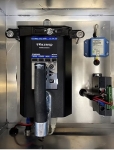Accurate perimeter air monitoring requires equipment that provides precise, real-time data on both dust and volatile organic compounds (VOCs). Classic 2.0 is a versatile monitoring system designed to measure particulate levels and compound-specific VOCs in a single integrated unit. Its compact design and automated functionality allow deployment in multiple locations across a site with minimal setup time.
Unified Dust and VOC Detection
Classic 2.0 combines high-performance gas chromatographs with particulate sensors. It measures total VOCs and individual compounds such as benzene, toluene, and xylene. When total VOC levels exceed thresholds, the field GC automatically switches to compound-specific analysis, providing detailed insights for every event.
Particulate sensors capture PM1, PM2.5, and PM10 data continuously. These sensors provide reliable measurements of dust levels, which are crucial for evaluating potential emissions during site activities. Data from both VOCs and particulate sensors are recorded together, offering a comprehensive view of air quality.
Simplified Installation and Deployment
The system is compact, portable, and ruggedized for outdoor deployment. Position the unit at the perimeter with unobstructed airflow for accurate sampling. Classic 2.0 can operate on AC power or battery, providing flexibility for temporary or long-term installations.
The compact size also ensures that multiple units can be deployed across different points around the perimeter. This distributed monitoring provides better spatial coverage, improving the accuracy of the perimeter air monitoring plan. Teams can respond faster to any detected increases in dust or VOC levels.
Structured Perimeter Air Monitoring
Classic 2.0 integrates seamlessly into a perimeter air monitoring plan. Sensor placement, sampling intervals, and threshold settings are easily configurable. Structured deployment ensures critical air quality events are detected accurately.
Correctly implementing the monitoring plan ensures that the system captures peak emissions during operational activities. Data can be analyzed in real-time, helping to track trends and assess potential impacts. Each unit operates as part of a coordinated network, maintaining consistency across the monitoring area.
Continuous operation guarantees that air quality is consistently assessed. The system's reporting capabilities support decision-making by providing clear, compound-specific VOC readings alongside particulate measurements. This structured approach increases reliability in daily monitoring efforts.
Continuous Real-Time Measurement
Classic 2.0 continuously samples the air and logs detailed VOC and particulate data. This ongoing measurement ensures that temporary spikes or fluctuations are captured immediately. Real-time data enables timely responses and better evaluation of operational impacts.
The intuitive dashboard visualizes current conditions and historical trends. Users can compare data over hours, days, or weeks to understand patterns in pollutant concentrations. Automated alerts notify operators if concentrations exceed predefined thresholds.
Automated Compound Identification
The field GC separates chemical mixtures via capillary columns and measures eluted compounds with sensitive detectors. This allows precise identification of VOCs within minutes. Detailed compound data is available instantly, improving the speed of analysis.
Automated operation reduces manual handling and potential errors in sampling. By detecting individual compounds, the system provides actionable insights that cannot be captured by generic total VOC meters. Users gain clarity on which chemicals are present during monitoring.
Remote Access and Monitoring
Classic 2.0 includes a mobile application to view real-time data remotely. Multiple units can be monitored simultaneously, enabling oversight across large sites. Users can access trends, set alerts, and export data for further analysis.
Remote dashboards provide instant visibility into site conditions. Data can be shared quickly among team members to coordinate monitoring efforts. This connectivity improves operational efficiency while ensuring data is always accessible.
The system supports long-term monitoring by logging information in a centralized platform. Users can track variations over time and compare data between different locations. This remote capability adds flexibility and enhances overall monitoring effectiveness.
Calibration and Maintenance Protocols
Routine calibration is essential for accurate measurements. Classic 2.0 supports scheduled calibration for both gas chromatographs and particulate sensors. Maintaining calibration ensures data accuracy and minimizes downtime during extended monitoring campaigns.
The system is designed for durability and low maintenance requirements. Its rugged construction allows continuous operation in outdoor conditions. Regular calibration ensures that readings remain precise and reliable over time.
These protocols maintain the integrity of monitoring results. Operators can trust that both dust and VOC measurements reflect actual conditions. Proper calibration is critical for maintaining the quality and reliability of the data collected.
Automated Reporting Features
Classic 2.0 generates comprehensive reports automatically. Daily, weekly, and project-long summaries are available for analysis. Automated reporting reduces manual data entry and supports consistent documentation.
Data logs are easily exportable for review or inclusion in project reports. This streamlines communication of monitoring results to stakeholders. Reporting features ensure transparency and reliability in documenting site air quality.
Strategic Sensor Placement
Placing sensors near dust emission sources and potential VOC release points enhances data accuracy. Rotating units based on activity patterns maximizes monitoring efficiency. Correct positioning ensures that readings reflect true perimeter air conditions.
Optimizing sensor placement helps identify critical zones for additional monitoring. By understanding site dynamics, users can ensure that key events are captured. This strategic approach improves overall monitoring effectiveness.
Proper placement ensures that data is representative of air quality across the perimeter. Units capture both routine and peak emissions consistently. This maximizes the value of the monitoring investment.
Integrated Monitoring Workflows
Classic 2.0 supports synchronized operation across multiple units. Sampling intervals and reporting schedules are coordinated to maintain consistent data collection. Centralized data management simplifies monitoring across large sites.
Integrated workflows ensure that each unit contributes to a cohesive monitoring plan. Users can access data in real-time and manage multiple sites efficiently. Coordination reduces gaps in coverage and improves overall monitoring quality.
Wind Up:
Classic 2.0 provides a reliable perimeter monitoring system through real-time VOC measurement and continuous dust tracking. Its automated operation, remote access, and reporting capabilities make it ideal for precise monitoring. The system enhances dust monitoring construction sites, offering consistent and actionable air quality data throughout operations.






